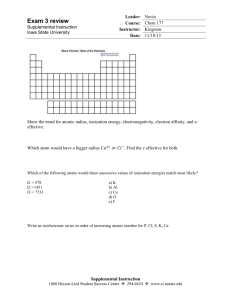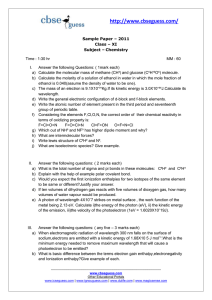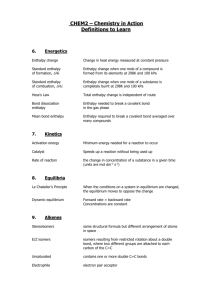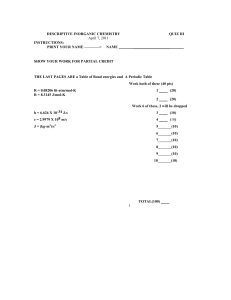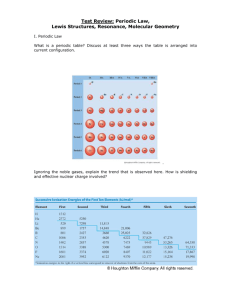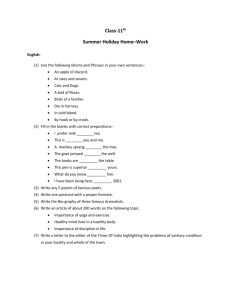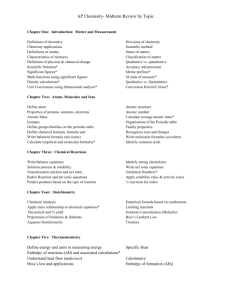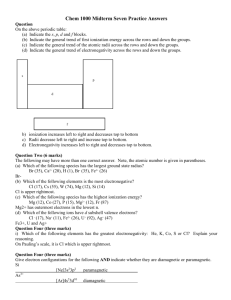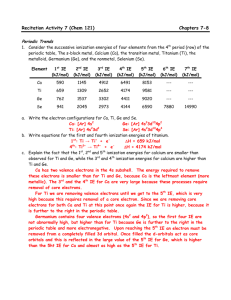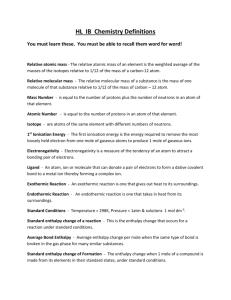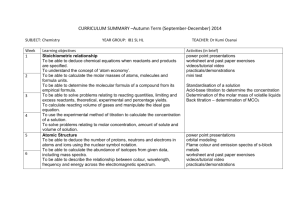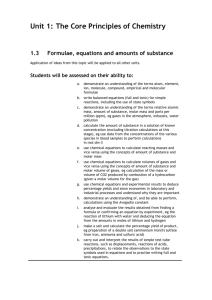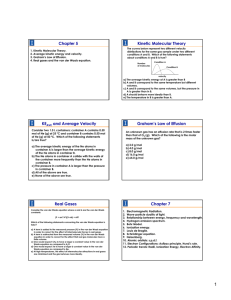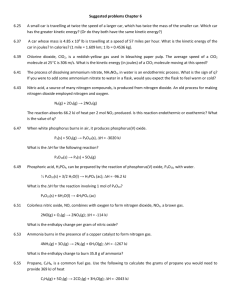HHW-XI
advertisement
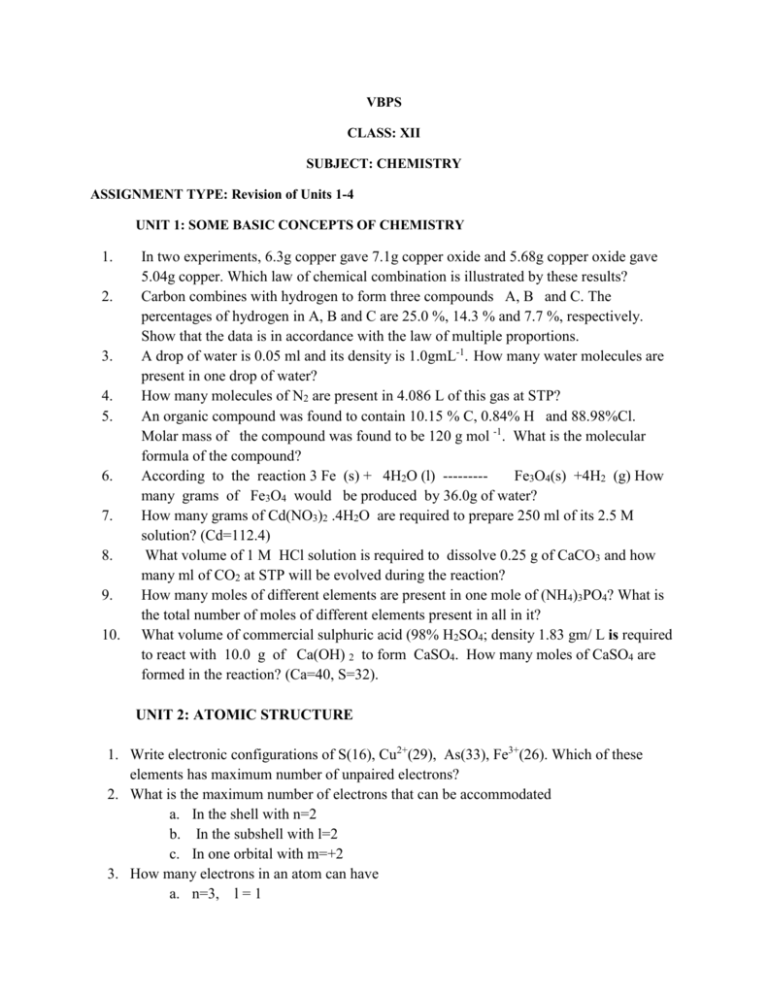
VBPS CLASS: XII SUBJECT: CHEMISTRY ASSIGNMENT TYPE: Revision of Units 1-4 UNIT 1: SOME BASIC CONCEPTS OF CHEMISTRY 1. 2. 3. 4. 5. 6. 7. 8. 9. 10. In two experiments, 6.3g copper gave 7.1g copper oxide and 5.68g copper oxide gave 5.04g copper. Which law of chemical combination is illustrated by these results? Carbon combines with hydrogen to form three compounds A, B and C. The percentages of hydrogen in A, B and C are 25.0 %, 14.3 % and 7.7 %, respectively. Show that the data is in accordance with the law of multiple proportions. A drop of water is 0.05 ml and its density is 1.0gmL-1. How many water molecules are present in one drop of water? How many molecules of N2 are present in 4.086 L of this gas at STP? An organic compound was found to contain 10.15 % C, 0.84% H and 88.98%Cl. Molar mass of the compound was found to be 120 g mol -1. What is the molecular formula of the compound? According to the reaction 3 Fe (s) + 4H2O (l) --------Fe3O4(s) +4H2 (g) How many grams of Fe3O4 would be produced by 36.0g of water? How many grams of Cd(NO3)2 .4H2O are required to prepare 250 ml of its 2.5 M solution? (Cd=112.4) What volume of 1 M HCl solution is required to dissolve 0.25 g of CaCO3 and how many ml of CO2 at STP will be evolved during the reaction? How many moles of different elements are present in one mole of (NH4)3PO4? What is the total number of moles of different elements present in all in it? What volume of commercial sulphuric acid (98% H2SO4; density 1.83 gm/ L is required to react with 10.0 g of Ca(OH) 2 to form CaSO4. How many moles of CaSO4 are formed in the reaction? (Ca=40, S=32). UNIT 2: ATOMIC STRUCTURE 1. Write electronic configurations of S(16), Cu2+(29), As(33), Fe3+(26). Which of these elements has maximum number of unpaired electrons? 2. What is the maximum number of electrons that can be accommodated a. In the shell with n=2 b. In the subshell with l=2 c. In one orbital with m=+2 3. How many electrons in an atom can have a. n=3, l = 1 b. n=4, l = 3 c. n =6, l =0 4. Which rule will be flouted by the following electronic configurations? a. 2 s3 b. 2s 22 px22py 12pz 0 c. 1s22s22p53s1 5. Which of the following orbitals are not possible: 6s, 1d, 5p, 2f, 4g. 6. What is the atomic number with electronic configuration 4p4? 7. What would be the maximum kinetic energy of an electron emitted by a light of wave length 2.0 x 10-8 cm from the surface of potassium metal whose work function is 3.62x 10-19 J? 8. Calculate the wavelength of light radiated when an electron in exited state falls from 3rd orbit to 1st orbit of hydrogen atom? 9. Calculate the uncertainity in the velocity of a cricket ball of mass 150 g, if uncertainity in its position is of the order of 1A0. 10. K.E of a moving electron is 2x10-25J. Calculate its de Broglie wavelength. UNIT: 3- CLASSIFICATION OF ELEMENTS AND PERIODICITY IN PROPERTIES 1. Locate the group number and period of the element with atomic number 55. 2. Locate the period number and group number of the element Uuu. Also find out the atomic number. 3. Which ion would be bigger in size ,X , X+, X 2+, X - OR X 24. Account for the fact that the first ionization enthalpy of 11Na is less than that of 12Mg but its second ionization enthalpy is very high than that of Mg. 5. First ionization enthalpy for 31Ga is lower than that of 30Zn. Explain? 6. Formation of oxide ion (O 2-) is an endothermic process as appears from the values of successive electron gain enthalpies of oxygen atom ; O (g) + e - ---------------O - (g) ∆ eg H1θ = -141KJ mol O- (g) + e- ------------- O 2- (g) ∆eg H2θ = +780kJ mol-1 7. Explain the stabilization of O 2-. 8. Electronic configuration of two elements A and B are A: 1s 22s2 2p3 B: 1s 22s2 2p 4 Which element has high electron gain enthalpy? Explain your choice. 9. Answer the following questions about the elements with the electronic configurations: A ……..3p6 4s2 B……...3P6 3d10 4s2 4p5 a. b. c. d. e. Is element A metal, metalloid or non-metal? Is element B metal, metalloid or non-metal? Which element has the highest ionization enthalpy? Which element has the greater electron gain enthalpy? Which element should be smaller of the two? 10: First and second ionization enthalpies (1E1 and 1E2) in kJ mol-1 for a few elements are given below; Element A B C D 1E1 419 1251 2372 738 Which of the above elements is likely to be a. b. c. d. A reactive metal A reactive non-metal A noble gas A metal that forms a stable oxide of the formula MO 1E2 3051 2297 5250 1451 CHEMICAL BONDING 1. Arrange the following with decreasing order of the property indicated. a. NH3, NH4, NH2………………………………………...bond angle. b. CCl4 , CHCl3, CH2Cl2, CH3Cl……………dipole moment. c. NH3, NF3, NCl3……………………………dipole moment. d. N2+, N2, N2-, N2 2-………………………..bond order. e. H2O, H2S, H2Sc, H2Te…………………….bpt. f. O2, O2+ O2 2+……………………………..bond length. g. CH3COCH3, C2H5OH, CH3COOH……….volatility. h. CH3 CH2OH, HO-CH2-CH2-OH, CH2(OH) CH(OH) CH2(OH)…viscosity. i. NO, CO, CO+……………………………..bond length. j. H2O, CF4, BF3………………………………bond angle. 2. Match the list 1 and 2 and write the correct matching. List 1 (species) List 2 (geometry) + a. H3O 1. Planar b. H2C==CH2 2.Angular c. ClO2 3. Tetrahedral + d. NH4 4. Trigonal bipyramidal e. PCl5 5. Pyramidal f. I3 6. T-shape g. ClF3 7. Square pyramid h. XeOF4 8. linear
